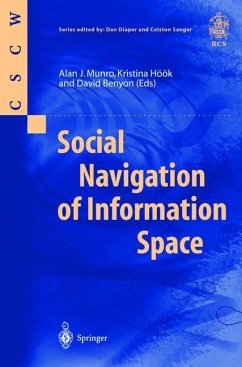Social Navigation of Information Space
Herausgegeben von Munro, Alan J.; Höök, Kristina; Benyon, David
Social Navigation of Information Space
Herausgegeben von Munro, Alan J.; Höök, Kristina; Benyon, David
- Broschiertes Buch
- Merkliste
- Auf die Merkliste
- Bewerten Bewerten
- Teilen
- Produkt teilen
- Produkterinnerung
- Produkterinnerung
Social navigation is a vibrant new field which examines how we navigate information spaces in "real" and "virtual" environments, how we orient and guide ourselves, and how we interact with and use others to find our way in information spaces. This approach brings a new way of thinking about how we design information spaces, emphasising our need to see others, collaborate with them, and follow the trails of their activities in these spaces. Social Navigation of Information Space is the first major work in this field, and includes contributions by many of the originators and key thinkers. It…mehr
Andere Kunden interessierten sich auch für
![Media Space 20+ Years of Mediated Life Media Space 20+ Years of Mediated Life]() Media Space 20+ Years of Mediated Life125,99 €
Media Space 20+ Years of Mediated Life125,99 €![Media Space 20+ Years of Mediated Life Media Space 20+ Years of Mediated Life]() Steve Harrison (ed.)Media Space 20+ Years of Mediated Life110,99 €
Steve Harrison (ed.)Media Space 20+ Years of Mediated Life110,99 €![Fieldwork for Design Fieldwork for Design]() David RandallFieldwork for Design103,99 €
David RandallFieldwork for Design103,99 €![Inhabited Information Spaces Inhabited Information Spaces]() David N. SnowdonInhabited Information Spaces122,99 €
David N. SnowdonInhabited Information Spaces122,99 €![Resources, Co-Evolution and Artifacts Resources, Co-Evolution and Artifacts]() Resources, Co-Evolution and Artifacts74,99 €
Resources, Co-Evolution and Artifacts74,99 €![Configuring User-Designer Relations Configuring User-Designer Relations]() Alex Voss / Mark Hartswood / Kate Ho / Rob Procter / Mark Rouncefield / Roger Slack / Monika Buscher (eds.)Configuring User-Designer Relations74,99 €
Alex Voss / Mark Hartswood / Kate Ho / Rob Procter / Mark Rouncefield / Roger Slack / Monika Buscher (eds.)Configuring User-Designer Relations74,99 €![Conceptual Modeling for User Interface Development Conceptual Modeling for User Interface Development]() David BenyonConceptual Modeling for User Interface Development41,99 €
David BenyonConceptual Modeling for User Interface Development41,99 €-
-
-
Social navigation is a vibrant new field which examines how we navigate information spaces in "real" and "virtual" environments, how we orient and guide ourselves, and how we interact with and use others to find our way in information spaces. This approach brings a new way of thinking about how we design information spaces, emphasising our need to see others, collaborate with them, and follow the trails of their activities in these spaces. Social Navigation of Information Space is the first major work in this field, and includes contributions by many of the originators and key thinkers. It will be of particular interest to researchers and students in areas related to CSCW and human computer interaction. As a thoroughly multi-disciplinary topic, it will also be of interest to researchers in cognitive psychology, social psychology, philosophy, linguistics, sociology, architecture and anthropology.
Hinweis: Dieser Artikel kann nur an eine deutsche Lieferadresse ausgeliefert werden.
Hinweis: Dieser Artikel kann nur an eine deutsche Lieferadresse ausgeliefert werden.
Produktdetails
- Produktdetails
- Computer Supported Cooperative Work
- Verlag: Springer / Springer London / Springer, Berlin
- Artikelnr. des Verlages: 978-1-85233-090-3
- 1st Edition.
- Seitenzahl: 296
- Erscheinungstermin: 13. August 1999
- Englisch
- Abmessung: 235mm x 155mm x 17mm
- Gewicht: 540g
- ISBN-13: 9781852330903
- ISBN-10: 1852330902
- Artikelnr.: 26719839
- Herstellerkennzeichnung Die Herstellerinformationen sind derzeit nicht verfügbar.
- Computer Supported Cooperative Work
- Verlag: Springer / Springer London / Springer, Berlin
- Artikelnr. des Verlages: 978-1-85233-090-3
- 1st Edition.
- Seitenzahl: 296
- Erscheinungstermin: 13. August 1999
- Englisch
- Abmessung: 235mm x 155mm x 17mm
- Gewicht: 540g
- ISBN-13: 9781852330903
- ISBN-10: 1852330902
- Artikelnr.: 26719839
- Herstellerkennzeichnung Die Herstellerinformationen sind derzeit nicht verfügbar.
1 Footprints in the Snow.- 1.1 Introduction.- 1.2 Mapping Social Navigation.- 1.3 Shifting Perspective.- 1.4 Social Navigation and Methodology.- 1.5 The Future of Social Navigation.- References.- 2 Where the Footprints Lead: Tracking Down Other Roles for Social Navigation.- 2.1 Introduction.- 2.2 Perspectives on Social Navigation.- 2.3 Spatial, Semantic and Social Navigation.- 2.4 New Opportunities for Social Navigation.- 2.5 Social Navigation and Collaborative Awareness.- 2.6 Social Navigation and Models of Space.- 2.7 Conclusions: New Opportunities for Social Navigation.- References.- 3 Social Connotations of Space in the Design for Virtual Communities and Social Navigation.- 3.1 Introduction.- 3.2 Social Navigation.- 3.3 Open Issues in Social Navigation.- 3.4 Social Connotations in Real and Virtual Spaces.- 3.5 Summary.- References.- 4 Informatics, Architecture and Language.- 4.1 What Underlies HCI?.- 4.2 Space Syntax.- 4.3 Information Structures Seen as Architectural Plans.- 4.4 The Path Model: An Information Access Approach Based on Activity.- 4.5 Conclusion.- References.- 5 Information that Counts: A Sociological View of Information Navigation.- 5.1 Introduction.- 5.2 The Fieldwork and the Setting.- 5.3 The Empirical Examples.- 5.4 Implications for Information Navigation on the Web.- 5.5 Conclusion.- Reference.- 6 Screen Scenery: Transposing Aesthetic Principles from Real to Electronic Environments.- 6.1 Introduction.- 6.2 Electronic Landscapes.- 6.3 The Ethnographic Study.- 6.4 Spatial Grammars.- 6.5 Presence and Orientation in Electronic Environments.- 6.6 Everyday Practices of Orientation and Perception and Spatial Grammars.- 6.7 Conclusion.- References.- 7 Navigating the Virtual Landscape: Co-ordinating the Shared Use of Space.- 7.1 Introduction.- 7.2 Shared Information Spaces.- 7.3 Methodological Approach and Research Setting.- 7.4 Observations.- 7.5 Summary and Conclusions: Co-ordinating the Shared Use of Space.- References.- 8 Spaces, Places, Landscapes and Views: Experiential Design of Shared Information Spaces.- 8.1 Introduction.- 8.2 Personal Spaces versus Public Places.- 8.3 Information Cities, Islands, Vehicles and Views.- 8.4 The Experiential Approach to HCI Design.- 8.5 Presences and Concealment.- 8.6 Conclusions.- References.- 9 The Conceptual Structure of Information Space.- 9.1 Introduction.- 9.2 Study: Users Describe Web Experience.- 9.3 Discussion.- 9.4 Conclusion.- References.- 10 A Contrast Between Information Navigation and Social Navigation in Virtual Worlds.- 10.1 Navigation.- 10.2 Home Hunting.- 10.3 Extension to Digital Representation and Social Navigation.- 10.4 Computer-Assisted Home-Hunting.- 10.5 Social Navigation: Cocktail Party Browsing.- 10.6 Computer-Assisted Remote Acquaintance.- 10.7 Comparisons: Information vs Social Navigation.- 10.8 Conclusions.- References.- 11 Understanding Representations of Space: A Comparison of Visualisation Techniques in Mainstream Cinema and Computer Interfaces.- 11.1 Introduction and Some Distinctions.- 11.2 Understanding Cinematic vs Digital Representations.- 11.3 Concluding Comments.- References.- 12 The Role of Wearables in Social Navigation.- 12.1 Introduction.- 12.2 Defining a Wearable.- 12.3 Wearables and Social Navigation.- 12.4 Augmentation.- 12.5 Time-Space Trajectories.- 12.6 Wearables in Context.- 12.7 Future Work.- 12.8 Summary - Creating Cultural Footprints.- References.- 13 Evaluating Adaptive Navigation Support.- 13.1 Introduction.- 13.2 Adaptive Navigation Systems.- 13.3 Evaluations of Adaptive Navigation Systems.- 13.4 Evaluation Criteria.- 13.5Summary.- References.- 14 Footsteps from the Garden - Arcadian Knowledge Spaces.- 14.0 Introduction: Personal and Social Navigation in Shared "Organic" Landscapes.- 14.2 Information Finding, Memory and Social Navigation.- 14.3 From Applications to Agents - Ecologies in the Interface.- 14.4 Organic Metaphors.- 14.3 The Knowledge Garden.- 14.4 (By Way of Some) Conclusions.- References.
1 Footprints in the Snow.- 1.1 Introduction.- 1.2 Mapping Social Navigation.- 1.3 Shifting Perspective.- 1.4 Social Navigation and Methodology.- 1.5 The Future of Social Navigation.- References.- 2 Where the Footprints Lead: Tracking Down Other Roles for Social Navigation.- 2.1 Introduction.- 2.2 Perspectives on Social Navigation.- 2.3 Spatial, Semantic and Social Navigation.- 2.4 New Opportunities for Social Navigation.- 2.5 Social Navigation and Collaborative Awareness.- 2.6 Social Navigation and Models of Space.- 2.7 Conclusions: New Opportunities for Social Navigation.- References.- 3 Social Connotations of Space in the Design for Virtual Communities and Social Navigation.- 3.1 Introduction.- 3.2 Social Navigation.- 3.3 Open Issues in Social Navigation.- 3.4 Social Connotations in Real and Virtual Spaces.- 3.5 Summary.- References.- 4 Informatics, Architecture and Language.- 4.1 What Underlies HCI?.- 4.2 Space Syntax.- 4.3 Information Structures Seen as Architectural Plans.- 4.4 The Path Model: An Information Access Approach Based on Activity.- 4.5 Conclusion.- References.- 5 Information that Counts: A Sociological View of Information Navigation.- 5.1 Introduction.- 5.2 The Fieldwork and the Setting.- 5.3 The Empirical Examples.- 5.4 Implications for Information Navigation on the Web.- 5.5 Conclusion.- Reference.- 6 Screen Scenery: Transposing Aesthetic Principles from Real to Electronic Environments.- 6.1 Introduction.- 6.2 Electronic Landscapes.- 6.3 The Ethnographic Study.- 6.4 Spatial Grammars.- 6.5 Presence and Orientation in Electronic Environments.- 6.6 Everyday Practices of Orientation and Perception and Spatial Grammars.- 6.7 Conclusion.- References.- 7 Navigating the Virtual Landscape: Co-ordinating the Shared Use of Space.- 7.1 Introduction.- 7.2 Shared Information Spaces.- 7.3 Methodological Approach and Research Setting.- 7.4 Observations.- 7.5 Summary and Conclusions: Co-ordinating the Shared Use of Space.- References.- 8 Spaces, Places, Landscapes and Views: Experiential Design of Shared Information Spaces.- 8.1 Introduction.- 8.2 Personal Spaces versus Public Places.- 8.3 Information Cities, Islands, Vehicles and Views.- 8.4 The Experiential Approach to HCI Design.- 8.5 Presences and Concealment.- 8.6 Conclusions.- References.- 9 The Conceptual Structure of Information Space.- 9.1 Introduction.- 9.2 Study: Users Describe Web Experience.- 9.3 Discussion.- 9.4 Conclusion.- References.- 10 A Contrast Between Information Navigation and Social Navigation in Virtual Worlds.- 10.1 Navigation.- 10.2 Home Hunting.- 10.3 Extension to Digital Representation and Social Navigation.- 10.4 Computer-Assisted Home-Hunting.- 10.5 Social Navigation: Cocktail Party Browsing.- 10.6 Computer-Assisted Remote Acquaintance.- 10.7 Comparisons: Information vs Social Navigation.- 10.8 Conclusions.- References.- 11 Understanding Representations of Space: A Comparison of Visualisation Techniques in Mainstream Cinema and Computer Interfaces.- 11.1 Introduction and Some Distinctions.- 11.2 Understanding Cinematic vs Digital Representations.- 11.3 Concluding Comments.- References.- 12 The Role of Wearables in Social Navigation.- 12.1 Introduction.- 12.2 Defining a Wearable.- 12.3 Wearables and Social Navigation.- 12.4 Augmentation.- 12.5 Time-Space Trajectories.- 12.6 Wearables in Context.- 12.7 Future Work.- 12.8 Summary - Creating Cultural Footprints.- References.- 13 Evaluating Adaptive Navigation Support.- 13.1 Introduction.- 13.2 Adaptive Navigation Systems.- 13.3 Evaluations of Adaptive Navigation Systems.- 13.4 Evaluation Criteria.- 13.5Summary.- References.- 14 Footsteps from the Garden - Arcadian Knowledge Spaces.- 14.0 Introduction: Personal and Social Navigation in Shared "Organic" Landscapes.- 14.2 Information Finding, Memory and Social Navigation.- 14.3 From Applications to Agents - Ecologies in the Interface.- 14.4 Organic Metaphors.- 14.3 The Knowledge Garden.- 14.4 (By Way of Some) Conclusions.- References.








